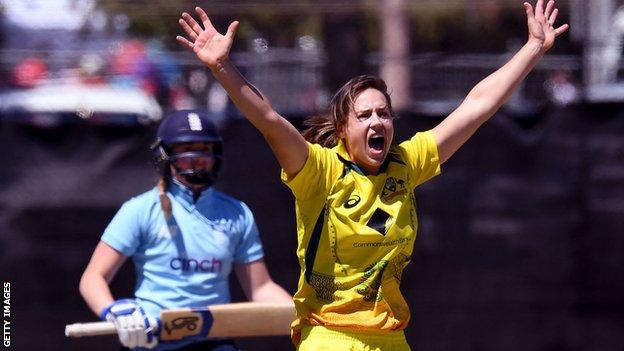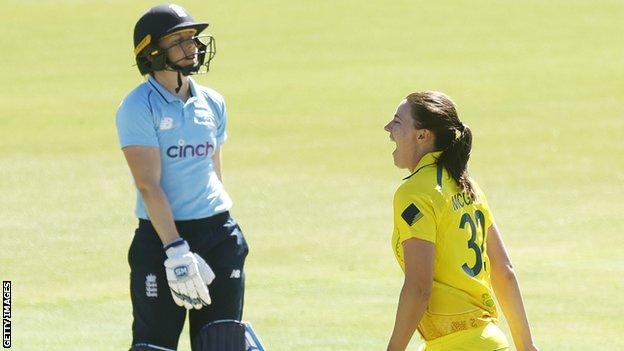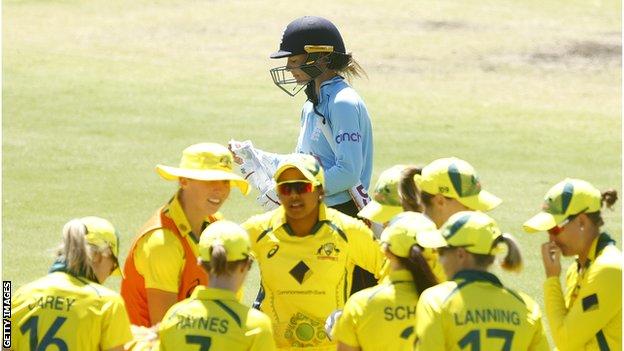With the women’s Ashes series run and won across all three formats, it’s time to look back at what became apparent about Australia’s juggernaut of a cricket team before the upcoming World Cup.
Ellyse Perry is not going anywhere

When the series started off with a 20-over match in Adelaide, there was a general sense of shock: Ellyse Perry was not playing.
Perry basically is Twenty20 cricket in Australia: the national team had played three times before her debut in 2008, and from that point on she played 126 of the next 148 matches. Now she was out.
Not injured, not rested, not rotated – not picked. Her scoring was not deemed fast enough and her bowling had lost bite.
As she came back for the longer formats though, Perry showed her class remains.
For once, she did not dominate the Test with the bat, though plenty of players would take 59 runs in a match.
But she did bowl really well with the new ball, taking 3-57 in the first innings to help set up Australia’s big lead.
She carried that into the one-dayers, by far the most frugal bowler at 2.3 runs per over, picking up four wickets at 11.5, and with the bat top-scoring in one run chase and not out in the other. Perry still has plenty to offer.
Tahlia McGrath has arrived

Someone who could complement Perry instead of supplanting her is fellow seaming all-rounder Tahlia McGrath, who first played for Australia in 2016 but has taken a few years to fire.
She did so last September with a stellar series against India, and carried that on in the Ashes.
It was McGrath who made that T20 team when Perry missed out. The South Australian made the most of it, belting 91 not out from 49 balls before taking 3-26. As you do.
She followed up with 52 and 34 in the Test match, with a couple of wickets, before adding six wickets in the one-dayers at an average of 10. Whenever she picks up bat or ball at the moment, things work for McGrath.
Bowling fast is dangerous

When we think about the risks of pelting a cricket ball, we usually think of the poor blighters being pelted by it. But doing the pelting takes its toll as well.
People have been excited for a while about 23-year-old Tayla Vlaeminck, who debuted more than three years ago.
Regularly approaching 77mph where a lot of seamers in the women’s game are more like 65, she is the most rapid Australian since the fastest of them all, Cathryn Fitzpatrick, retired in 2007.
But it takes a toll. Just before the T20 World Cup in 2020 she suffered a stress fracture in her foot, missing a year of cricket to let it heal.
This year she played the first Ashes T20, then the same bone fractured again. It will be another slow return for a fast bowler.
Beth Mooney might be Australia’s best – and bravest

In the beginning, Australia’s most important player, and the highest billing, was always Perry.
Eventually Meg Lanning came to join her as a batting powerhouse and young captain.
Alyssa Healy joined the ranks when her batting came good. But over the past couple of years, there is a good case to be made that the most reliable, most versatile, and maker of the toughest runs, is Mooney.
She opens the batting for Australia in T20s, made the most runs in the 2020 World Cup, top-scored with 78 not out in the final, and won the Belinda Clark Award for best Australian player of the year.
In the longer forms though she bats in the middle order and puts out fires. Her 125 not out against India last September rescued an impossible one-dayer.
She did the same job with 73 when England looked certain to win the first Ashes ODI, and that was after an important 63 in the Test.
More impressively, those latter two innings were scored with a broken jaw, fractured while batting in the nets. She missed the Ashes T20s but got wired up and declared herself fit to play the Test nine days later.
Batting at least had a helmet and grille, but her fielding was fearless, including at a short straight mid-off 10 paces from the bat.
In the Test’s final overs, she came flying in from long-on to take a vital catch diving forward, unheeding of the injury, to dismiss Sophia Dunkley.
Mooney was put on ice once the trophy was retained, but when a really hard job needs doing, she’s made herself the player to do it.
Australia have all the options

As England struggled to pick a team through the series, with the batting ending too early at number six and a lack of bowling from the top order, Australia have a luxury of options.
In the team picked for the past two matches they could claim to have seven all-rounders, with eight bowling options and with batting down to number 10.
Even when Mooney comes back as a specialist bat and Brown as a specialist bowler, the team will still have Healy the wicketkeeper opening the batting, Perry the opening bowler at four, McGrath the seamer at six, Ashleigh Gardner who hits long bombs and bowls off-spin at seven, either Annabel Sutherland or Nicola Carey at eight as death bowlers who could also bat top order, then Jess Jonassen or Alana King at nine as spinners who can make proper runs.
As Australia go into the 50-over World Cup, any combination of options from the squad looks capable of forming an imposing team. It is hard to envisage anybody matching that.

